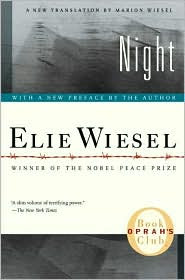 Elie Wiesel won the Nobel Peace Prize in 1986.
Elie Wiesel won the Nobel Peace Prize in 1986.In some ways the 100-page Night is the iconic Holocaust memoir. In spare and powerful prose, Weisel documents what he observed and what he experienced when he was an adolescent.
When Hitler comes to power, the Jewish community of Sighet, in Transylvania (modern Romania) where Wiesel comes from, does not believe the worst can happen. They are shocked to see the Germans invade their town. They consult amongst themselves. They must obey the Jewish police, the local police, and the Nazis who give orders to everyone. They must surrender their possessions. They prepare for the worst. They obey orders once all other options have been exhausted. Family members cling to each other. They are forced to leave their homes and they are herded into a ghetto in an area designated by the Nazis. They are then forced in groups into cattle cars to other destinations: work camps and extermination camps. Different members of the community suffer different fates and families who have tried to look out for each other are split up. In Weisel’s case he and his father are together, and they work at keeping each other alive as they are moved from Auschwitz to Buchenwald. In the course of this movingly written memoir, Weisel recounts resourcefulness, good luck, bad luck, generosity, selfishness, hope, despair, brutality, hunger, fear, exhaustion, sickness, death.
Night, which was originally rejected by many publishers because they did not think it would sell, has now sold over ten million copies. Like The Diary of Anne Frank, Night is taught in many different school settings. It is, of course, a different story from Anne Frank’s in many ways. The Diary of Anne Frank is the story of families in hiding. Night is the story of life and death in the concentration camps, but they are an interesting pair nonetheless. Both authors were adolescents during the war and you see what is happening in their world through the eyes and their innocence which serves to magnify the horror.
Talks and interviews with Elie Wiesel are easy to find on the internet. Click here to watch a talk he gave which also includes a question and answer period at the University of California at Santa Barbara in February of 2008.
If you would like to read a scholarly article about British Prisoners of War and their reaction to the Jewish inmates at Auschwitz published in the Journal of Holocaust and Genocide Studies click here.
To read a 2/18/11 New York Times article on current thoughts about the need for new kinds of exhibitions at Auschwitz written by Michael Kimmelman, click here.
People
Hilda, author’s oldest sister
Bea, author’s sister
Eliezer (Elie) Wiesel, author
Tzipporah, author’s youngest sister
Batia Riech – a relative who was living with the Wiesels
Reizel Stein – a relative who lived in Antwerp – she and her children killed
Akiba Drumer – was at Auschwitz with the author
Hersch Genud – was at Auschwitz with the author
Places
Sighet – author’s home town; in Transylvania
Forest near Kolomaye, Galicia
Auschwitz (Buna)
Buchenwald

No comments:
Post a Comment